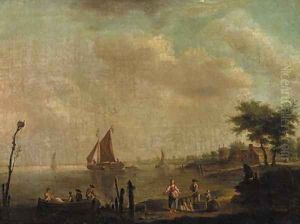Hendrik Willem Schweickhardt Paintings
Hendrik Willem Schweickhardt was born on June 28, 1746, in Cleves, Prussia (now Germany), and developed into a notable artist of the 18th century. His work spans a variety of genres, including landscape painting, portraiture, and still-life, demonstrating a versatile and refined skill set that was appreciated in his time and has continued to be recognized by art historians and collectors alike.
Schweickhardt showed an early interest in art, which led him to pursue his passion with dedication. Throughout his career, Schweickhardt traveled extensively, which influenced his artistic style and subject matter. His travels through Europe, particularly in the Netherlands and England, exposed him to various artistic movements and techniques, which he adeptly incorporated into his own work.
In the Netherlands, Schweickhardt was influenced by the Dutch Golden Age painters, whose attention to detail, use of light, and landscape compositions can be seen reflected in his work. His landscapes are particularly noted for their serene beauty and meticulous detail, capturing the essence of the Dutch countryside with a poetic sensitivity. Schweickhardt's still-life paintings also show a remarkable attention to detail and a mastery of texture and color, making them highly prized.
Later in his career, Schweickhardt moved to England, where he continued to work and exhibit his art. His time in England marked a significant phase in his career, as he became known for his portraits, which were highly regarded for their elegance and depth of character. Schweickhardt's portraits not only captured the physical likeness of his subjects but also their personality and social status, reflecting the cultural and artistic milieu of Georgian Britain.
Despite his talent and the acclaim he received during his lifetime, Hendrik Willem Schweickhardt has not been as widely recognized as some of his contemporaries. Nevertheless, his contributions to the art world, particularly in the realms of landscape and portrait painting, continue to be appreciated by those who study 18th-century European art. Schweickhardt's work is held in various private collections and museums, where it continues to be studied and admired.
Hendrik Willem Schweickhardt passed away on March 14, 1797, leaving behind a legacy of artistic achievement that captures the spirit and aesthetics of his time. His work remains a testament to his skill, dedication, and the diverse influences that shaped his artistic journey.
